Ngan Le
Learning Human Motion with Temporally Conditional Mamba
Oct 14, 2025Abstract:Learning human motion based on a time-dependent input signal presents a challenging yet impactful task with various applications. The goal of this task is to generate or estimate human movement that consistently reflects the temporal patterns of conditioning inputs. Existing methods typically rely on cross-attention mechanisms to fuse the condition with motion. However, this approach primarily captures global interactions and struggles to maintain step-by-step temporal alignment. To address this limitation, we introduce Temporally Conditional Mamba, a new mamba-based model for human motion generation. Our approach integrates conditional information into the recurrent dynamics of the Mamba block, enabling better temporally aligned motion. To validate the effectiveness of our method, we evaluate it on a variety of human motion tasks. Extensive experiments demonstrate that our model significantly improves temporal alignment, motion realism, and condition consistency over state-of-the-art approaches. Our project page is available at https://zquang2202.github.io/TCM.
Interpreting Radiologist's Intention from Eye Movements in Chest X-ray Diagnosis
Jul 16, 2025Abstract:Radiologists rely on eye movements to navigate and interpret medical images. A trained radiologist possesses knowledge about the potential diseases that may be present in the images and, when searching, follows a mental checklist to locate them using their gaze. This is a key observation, yet existing models fail to capture the underlying intent behind each fixation. In this paper, we introduce a deep learning-based approach, RadGazeIntent, designed to model this behavior: having an intention to find something and actively searching for it. Our transformer-based architecture processes both the temporal and spatial dimensions of gaze data, transforming fine-grained fixation features into coarse, meaningful representations of diagnostic intent to interpret radiologists' goals. To capture the nuances of radiologists' varied intention-driven behaviors, we process existing medical eye-tracking datasets to create three intention-labeled subsets: RadSeq (Systematic Sequential Search), RadExplore (Uncertainty-driven Exploration), and RadHybrid (Hybrid Pattern). Experimental results demonstrate RadGazeIntent's ability to predict which findings radiologists are examining at specific moments, outperforming baseline methods across all intention-labeled datasets.
Deep Learning for Ophthalmology: The State-of-the-Art and Future Trends
Jan 07, 2025



Abstract:The emergence of artificial intelligence (AI), particularly deep learning (DL), has marked a new era in the realm of ophthalmology, offering transformative potential for the diagnosis and treatment of posterior segment eye diseases. This review explores the cutting-edge applications of DL across a range of ocular conditions, including diabetic retinopathy, glaucoma, age-related macular degeneration, and retinal vessel segmentation. We provide a comprehensive overview of foundational ML techniques and advanced DL architectures, such as CNNs, attention mechanisms, and transformer-based models, highlighting the evolving role of AI in enhancing diagnostic accuracy, optimizing treatment strategies, and improving overall patient care. Additionally, we present key challenges in integrating AI solutions into clinical practice, including ensuring data diversity, improving algorithm transparency, and effectively leveraging multimodal data. This review emphasizes AI's potential to improve disease diagnosis and enhance patient care while stressing the importance of collaborative efforts to overcome these barriers and fully harness AI's impact in advancing eye care.
Progressive Multi-granular Alignments for Grounded Reasoning in Large Vision-Language Models
Dec 11, 2024Abstract:Existing Large Vision-Language Models (LVLMs) excel at matching concepts across multi-modal inputs but struggle with compositional concepts and high-level relationships between entities. This paper introduces Progressive multi-granular Vision-Language alignments (PromViL), a novel framework to enhance LVLMs' ability in performing grounded compositional visual reasoning tasks. Our approach constructs a hierarchical structure of multi-modal alignments, ranging from simple to complex concepts. By progressively aligning textual descriptions with corresponding visual regions, our model learns to leverage contextual information from lower levels to inform higher-level reasoning. To facilitate this learning process, we introduce a data generation process that creates a novel dataset derived from Visual Genome, providing a wide range of nested compositional vision-language pairs. Experimental results demonstrate that our PromViL framework significantly outperforms baselines on various visual grounding and compositional question answering tasks.
A2VIS: Amodal-Aware Approach to Video Instance Segmentation
Dec 02, 2024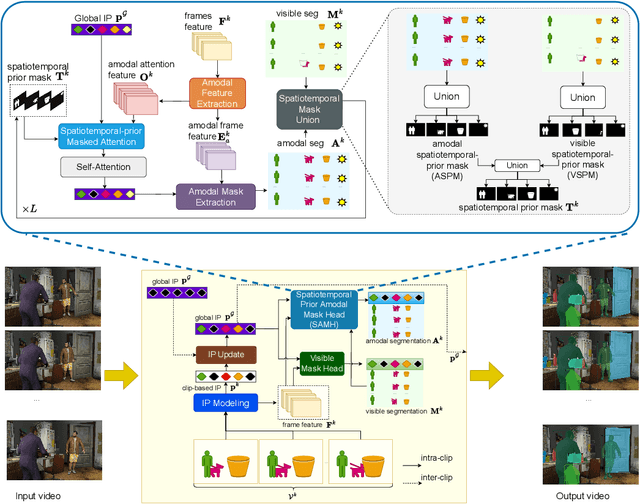
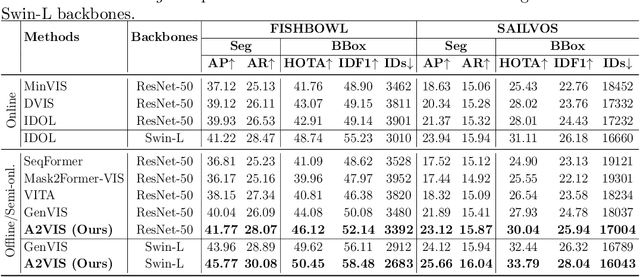
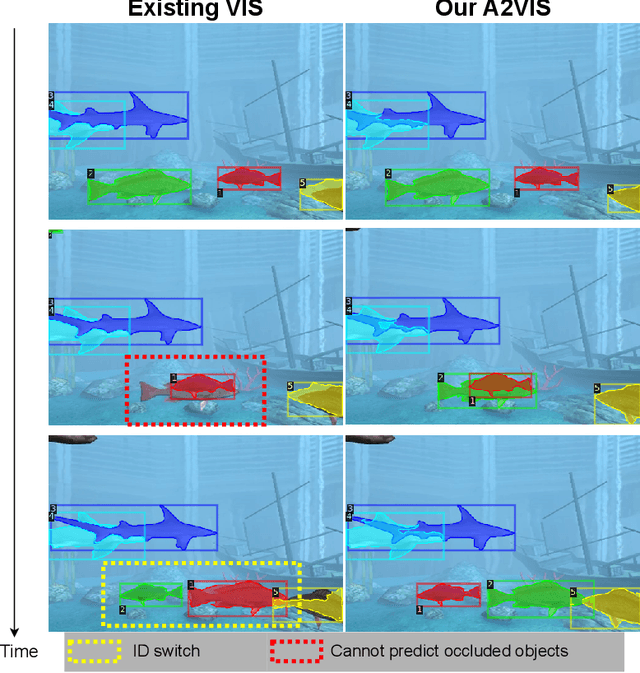

Abstract:Handling occlusion remains a significant challenge for video instance-level tasks like Multiple Object Tracking (MOT) and Video Instance Segmentation (VIS). In this paper, we propose a novel framework, Amodal-Aware Video Instance Segmentation (A2VIS), which incorporates amodal representations to achieve a reliable and comprehensive understanding of both visible and occluded parts of objects in a video. The key intuition is that awareness of amodal segmentation through spatiotemporal dimension enables a stable stream of object information. In scenarios where objects are partially or completely hidden from view, amodal segmentation offers more consistency and less dramatic changes along the temporal axis compared to visible segmentation. Hence, both amodal and visible information from all clips can be integrated into one global instance prototype. To effectively address the challenge of video amodal segmentation, we introduce the spatiotemporal-prior Amodal Mask Head, which leverages visible information intra clips while extracting amodal characteristics inter clips. Through extensive experiments and ablation studies, we show that A2VIS excels in both MOT and VIS tasks in identifying and tracking object instances with a keen understanding of their full shape.
FG-CXR: A Radiologist-Aligned Gaze Dataset for Enhancing Interpretability in Chest X-Ray Report Generation
Nov 23, 2024



Abstract:Developing an interpretable system for generating reports in chest X-ray (CXR) analysis is becoming increasingly crucial in Computer-aided Diagnosis (CAD) systems, enabling radiologists to comprehend the decisions made by these systems. Despite the growth of diverse datasets and methods focusing on report generation, there remains a notable gap in how closely these models' generated reports align with the interpretations of real radiologists. In this study, we tackle this challenge by initially introducing Fine-Grained CXR (FG-CXR) dataset, which provides fine-grained paired information between the captions generated by radiologists and the corresponding gaze attention heatmaps for each anatomy. Unlike existing datasets that include a raw sequence of gaze alongside a report, with significant misalignment between gaze location and report content, our FG-CXR dataset offers a more grained alignment between gaze attention and diagnosis transcript. Furthermore, our analysis reveals that simply applying black-box image captioning methods to generate reports cannot adequately explain which information in CXR is utilized and how long needs to attend to accurately generate reports. Consequently, we propose a novel explainable radiologist's attention generator network (Gen-XAI) that mimics the diagnosis process of radiologists, explicitly constraining its output to closely align with both radiologist's gaze attention and transcript. Finally, we perform extensive experiments to illustrate the effectiveness of our method. Our datasets and checkpoint is available at https://github.com/UARK-AICV/FG-CXR.
GazeSearch: Radiology Findings Search Benchmark
Nov 08, 2024



Abstract:Medical eye-tracking data is an important information source for understanding how radiologists visually interpret medical images. This information not only improves the accuracy of deep learning models for X-ray analysis but also their interpretability, enhancing transparency in decision-making. However, the current eye-tracking data is dispersed, unprocessed, and ambiguous, making it difficult to derive meaningful insights. Therefore, there is a need to create a new dataset with more focus and purposeful eyetracking data, improving its utility for diagnostic applications. In this work, we propose a refinement method inspired by the target-present visual search challenge: there is a specific finding and fixations are guided to locate it. After refining the existing eye-tracking datasets, we transform them into a curated visual search dataset, called GazeSearch, specifically for radiology findings, where each fixation sequence is purposefully aligned to the task of locating a particular finding. Subsequently, we introduce a scan path prediction baseline, called ChestSearch, specifically tailored to GazeSearch. Finally, we employ the newly introduced GazeSearch as a benchmark to evaluate the performance of current state-of-the-art methods, offering a comprehensive assessment for visual search in the medical imaging domain.
Guide3D: A Bi-planar X-ray Dataset for 3D Shape Reconstruction
Oct 29, 2024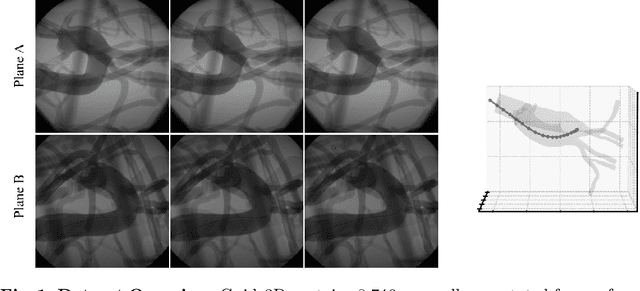
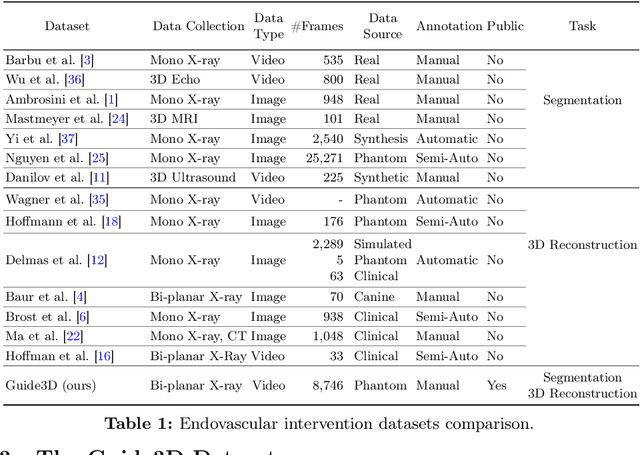
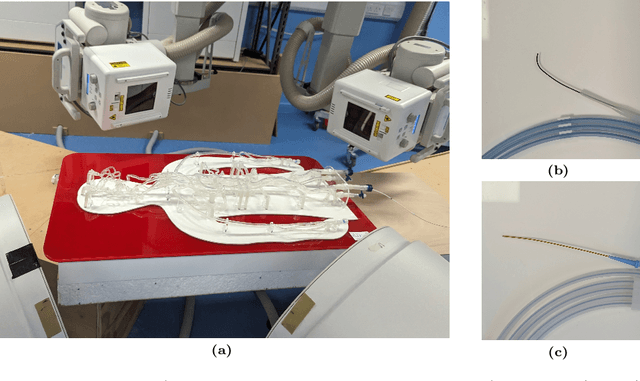

Abstract:Endovascular surgical tool reconstruction represents an important factor in advancing endovascular tool navigation, which is an important step in endovascular surgery. However, the lack of publicly available datasets significantly restricts the development and validation of novel machine learning approaches. Moreover, due to the need for specialized equipment such as biplanar scanners, most of the previous research employs monoplanar fluoroscopic technologies, hence only capturing the data from a single view and significantly limiting the reconstruction accuracy. To bridge this gap, we introduce Guide3D, a bi-planar X-ray dataset for 3D reconstruction. The dataset represents a collection of high resolution bi-planar, manually annotated fluoroscopic videos, captured in real-world settings. Validating our dataset within a simulated environment reflective of clinical settings confirms its applicability for real-world applications. Furthermore, we propose a new benchmark for guidewrite shape prediction, serving as a strong baseline for future work. Guide3D not only addresses an essential need by offering a platform for advancing segmentation and 3D reconstruction techniques but also aids the development of more accurate and efficient endovascular surgery interventions. Our project is available at https://airvlab.github.io/guide3d/.
TrackMe:A Simple and Effective Multiple Object Tracking Annotation Tool
Oct 20, 2024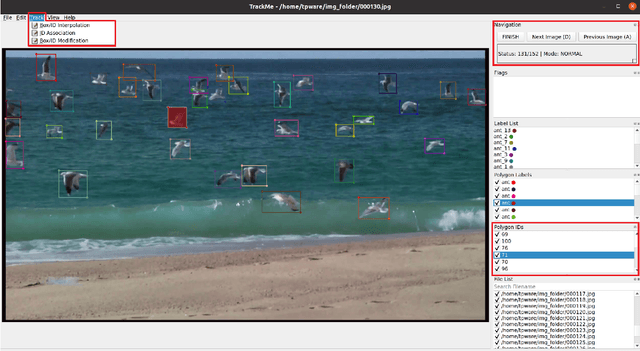
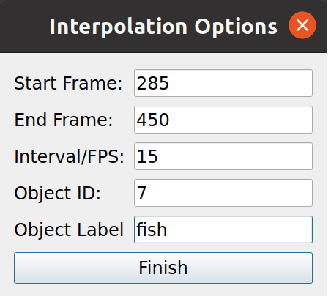
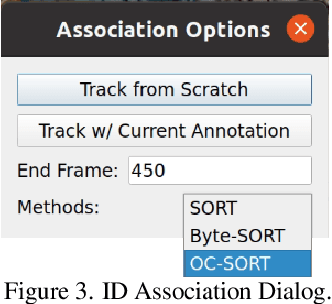

Abstract:Object tracking, especially animal tracking, is one of the key topics that attract a lot of attention due to its benefits of animal behavior understanding and monitoring. Recent state-of-the-art tracking methods are founded on deep learning architectures for object detection, appearance feature extraction and track association. Despite the good tracking performance, these methods are trained and evaluated on common objects such as human and cars. To perform on the animal, there is a need to create large datasets of different types in multiple conditions. The dataset construction comprises of data collection and data annotation. In this work, we put more focus on the latter task. Particularly, we renovate the well-known tool, LabelMe, so as to assist common user with or without in-depth knowledge about computer science to annotate the data with less effort. The new tool named as TrackMe inherits the simplicity, high compatibility with varied systems, minimal hardware requirement and convenient feature utilization from the predecessor. TrackMe is an upgraded version with essential features for multiple object tracking annotation.
DINTR: Tracking via Diffusion-based Interpolation
Oct 14, 2024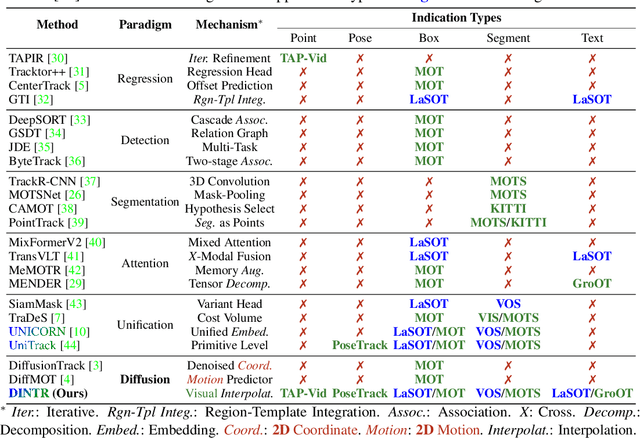


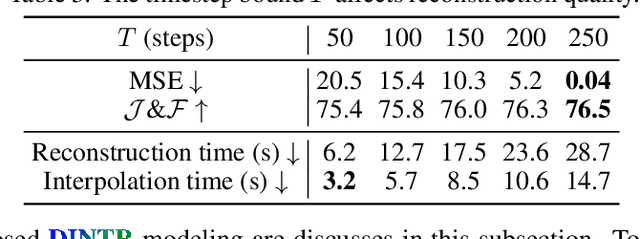
Abstract:Object tracking is a fundamental task in computer vision, requiring the localization of objects of interest across video frames. Diffusion models have shown remarkable capabilities in visual generation, making them well-suited for addressing several requirements of the tracking problem. This work proposes a novel diffusion-based methodology to formulate the tracking task. Firstly, their conditional process allows for injecting indications of the target object into the generation process. Secondly, diffusion mechanics can be developed to inherently model temporal correspondences, enabling the reconstruction of actual frames in video. However, existing diffusion models rely on extensive and unnecessary mapping to a Gaussian noise domain, which can be replaced by a more efficient and stable interpolation process. Our proposed interpolation mechanism draws inspiration from classic image-processing techniques, offering a more interpretable, stable, and faster approach tailored specifically for the object tracking task. By leveraging the strengths of diffusion models while circumventing their limitations, our Diffusion-based INterpolation TrackeR (DINTR) presents a promising new paradigm and achieves a superior multiplicity on seven benchmarks across five indicator representations.
 Add to Chrome
Add to Chrome Add to Firefox
Add to Firefox Add to Edge
Add to Edge